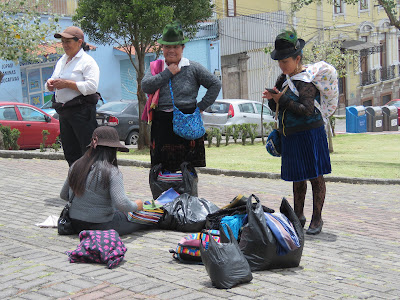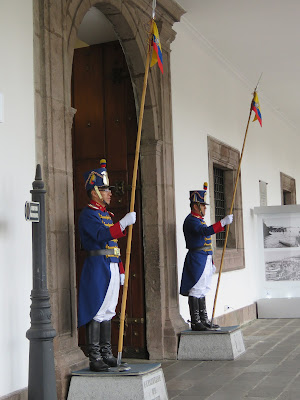Oct 20, 2017
Hummingbirds of Cabañas San Isidro, Ecuador, October 6th, 2017
The hummingbird feeders at Cabañas San Isidro attracted a lot of birds (and insects!).
Chestnut - breasted Coronet (Boissonneaua matthewsii) – 12 cm, 7 gram, was by far the most common of the hummingbirds around the feeders. It was not shy and we could get very close to it. It was also rather dominant and agressiv towards the other hummingbirds, and sometimes even attacking us
The view from the veranda of the lodge.
Fawn-breasted Brilliant (Heliodoxa rubinoides); Lillastrubet Brillant at the feeder.
Gorgeted Woodstar (Chaetocercus heliodor) Kraveskovstjerne; Gorgeted Woodstar is 7 cm (2.7 in) in total length, making it one of the smallest birds native to South America,
Sparkling Violetear¸ (Colibri coruscans)¸ Glitrende violetøre
Long - tailed Sylph, male.
A constructive dialogue is a good basis for a mutual understanding. Chestnut - breasted Coronets
Sparkling Violetear¸ (Colibri coruscans)¸ Glitrende violetøre
From Quito to the Amazon catchment, Ecuador, October 5th, 2017
In the upper part of the Amazon jungle. I'm sitting on a terrace next to the jungle surrounded by swirling hummingbirds (not because I'm here but because there are some feeders with sugar-water at the edge of the terrace!). While the rest of our team of botanists are looking at the many exciting plants in the jungle.
We left Quito and drove east towards the Amazon. We continued to Cosanga where we spend the night at Cabañas San Isidro.
Ready for departure from Quito, view from the street next to our hotel. Parat til afgang fra Quito, udsigt fra gaden ud for vores hotel.
Our first botanical stop was at the pass of the Andes Mountains (Páramo de la Virgen 4,064 meters above sea level) where the road leads you from Quito and go down to the Amazon basin.
The paramo hosts a great variety of plants and flowers.
First hummingbird of the trip: the giant hummingbird. The giant hummingbird (Patagona gigas) is the largest member of the hummingbird family, weighing 18–24 g.
The páramo is a montane ecosystem with predominance of scrub vegetation. Páramos are usually located from altitudes of approximately 2700 meter above sea level.
Next stop was the Guango Lodge (2.700 m.o.h.). It was well equipped with hummingbird feeders, attracting a variety of hummingbirds.
We had a small hike in the rainforest around Guango lodge.
Old Quito, Ecuador, October 4, 2017
Quito’s chief attraction is the old town and its dazzling array of churches, monasteries, convents and colonial style houses dating from the early days of the colony.
Quito is in many ways similar to Tbilisi in Georgia where I have spent 3 years. Mixture of modern glass buildings for business, lots of restaurants, old houses mixed with new buildings, limited town planning, chaotic traffic.
The Basílica del Voto Nacional is the tallest church in Ecuador, thanks to its two imposing, 115-metre towers plainly visible throughout the city. Built in a flamboyant, neo-Gothic style, it’s a wild concoction of spires, flying buttresses, turrets, parapets, arches, gables and elaborate stained-glass windows. Despite construction beginning in 1892, the church – which is built largely in concrete – is still not entirely completed.
The gargoyles, based on Ecuadorian fauna such as anteaters, monkeys and jaguars, are a contemporary departure from the traditional representations of mythical creatures.
Some ladies from another part of Eucadors having a business selling pretty colored scarfs pretending to be local produce.
The central courtyard of the original Archbishop's palace at the Plaza de la Independencia has become a commercial center.
Plaza de la Independencia
Barber shop (one of the oldest in South America) at Palacio de Gobierno, situated at Plaza de la Independencia.
Guards at the entrance to Palacio de Gobierno, the seat of the Ecuadorian presidency.
Demonstration at the Plaza de la Independencia where demonstrators call for clarity about the many missing people in Ecuador.
Old town skyline
Inside of the Church and Convent of St. Francis at Plaza San Francisco
There was a lot of barking going inside the church when we visited it. And it turned out that a very popular mass was in progress where dog owners could have their dogs blessed.
One of the city's dogs on its way to being blessed.
Market, Quito, Ecuador, October 4, 2017
The the first day of our trip to Ecuador with the Danish Botanical Society was devoted to exploring the capital. Our first stop was to a market near our hotel.
The nice lady helped our Danish guide with showing some of the delicious fruits produced in Ecuador
Our Ecuadorian guide Gustavo showing one of Ecuador’s main crops: Cacao.
Two local ladies in the process of something
Christianity is everywhere in Ecuador, here a small chapel at the market (in the background).
There were also live music.
In the corner of the market there were some stands with medical herbs.
Flowers are one of Ecuador's major export items, and we were told that Ecuador is the world's largest producer of roses.
Subscribe to:
Posts (Atom)






































